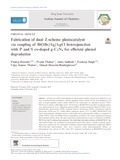JavaScript is disabled for your browser. Some features of this site may not work without it.
| dc.contributor.author | Raizada, Pankaj | |
| dc.contributor.author | Thakur, Prachi | |
| dc.contributor.author | Sudhaik, Anita | |
| dc.contributor.author | Singh, Pardeep | |
| dc.contributor.author | Thakur, Vijay Kumar | |
| dc.contributor.author | Hosseini-Bandegharaei, Ahmad | |
| dc.date.accessioned | 2019-11-12T12:39:24Z | |
| dc.date.available | 2019-11-12T12:39:24Z | |
| dc.date.issued | 2019-10-15 | |
| dc.identifier.citation | Raizada P, Thakur P, Sudhaik A, et al., (2020) Fabrication of dual Z-scheme photocatalyst via coupling of BiOBr/Ag/AgCl heterojunction with P and S co-doped g-C3N4 for efficient phenol degradation. Arabian Journal of Chemistry, Volume 13, Issue 3, March 2020, pp. 4538-4552 | en_UK |
| dc.identifier.issn | 1878-5352 | |
| dc.identifier.uri | https://doi.org/10.1016/j.arabjc.2019.10.001 | |
| dc.identifier.uri | https://dspace.lib.cranfield.ac.uk/handle/1826/14714 | |
| dc.description.abstract | Advances in noble metal mediated Z-scheme photocatalytic system have ushered in a climax on environmental remediation. Herein, graphitic carbon nitride (GCN) and phosphorus sulphur co-doped graphitic carbon nitride (PSCN) were synthesized via calcination process. GCN, PSCN and Z-scheme visible light driven (VLD) ternary BiOBr/PSCN/Ag/AgCl nanophotocatalyst were characterized by X-ray diffraction pattern (XRD), Fourier transform infrared (FTIR), X-ray photoelectron spectroscopy (XPS), scanning electron microscopy (SEM), transmission electron microscopy (TEM) and UV–visible diffuse reflectance spectra (UV–vis DRS). BiOBr/PSCN/Ag/AgCl nanocomposite exhibited superior visible light driven photocatalytic ability as compared to pristine PSCN, AgCl and BiOBr towards degradation of phenol. The results explicated promising photocatalytic activity along with space separation of photocarriers caused via formation of BiOBr/PSCN/Ag/AgCl Z-scheme heterojunction. The visible light absorption efficacy of BiOBr/PSCN/Ag/AgCl photocatalyst was confirmed by photoluminescence (PL) spectra. Finally, recycling experiments were explored for the mechanistic detailing of phenol photodegradation employing BiOBr/PSCN/Ag/AgCl photocatalyst. After seven successive cycles photodegradation efficacy of photocatalyst was reduced to 90% from 98%. Proposed mechanism of BiOBr/PSCN/Ag/AgCl nanophotocatalyst for degradation of phenol was discussed. OH and O2− radicals were main reactive species responsible for photocatalytic phenol degradation. | en_UK |
| dc.language.iso | en | en_UK |
| dc.publisher | Elsevier | en_UK |
| dc.rights | Attribution-NonCommercial-NoDerivatives 4.0 International | * |
| dc.rights.uri | http://creativecommons.org/licenses/by-nc-nd/4.0/ | * |
| dc.subject | BiOBr | en_UK |
| dc.subject | Ag/AgCl | en_UK |
| dc.subject | P and S co-doped g-C3N4 | en_UK |
| dc.subject | Dual Z-scheme approach | en_UK |
| dc.subject | Enhanced photocatalysis | en_UK |
| dc.subject | Phenol degradation | en_UK |
| dc.title | Fabrication of dual Z-scheme photocatalyst via coupling of BiOBr/Ag/AgCl heterojunction with P and S co-doped g-C3N4 for efficient phenol degradation | en_UK |
| dc.type | Article | en_UK |
Files in this item
The following license files are associated with this item:
This item appears in the following Collection(s)
-
Staff publications (SATM) [4365]

